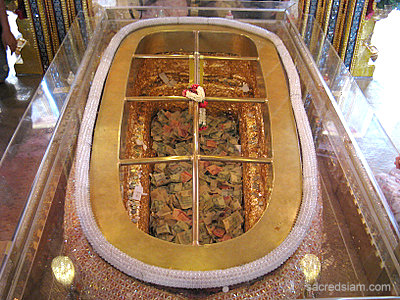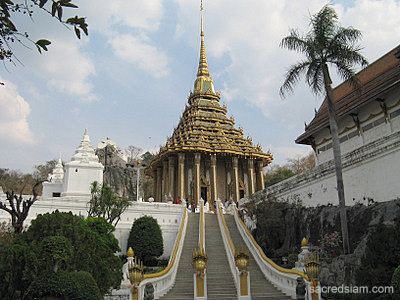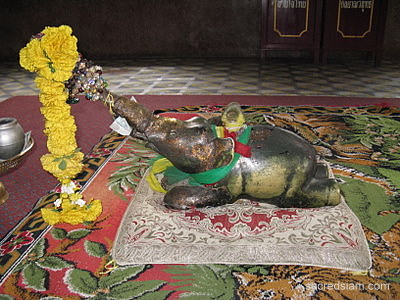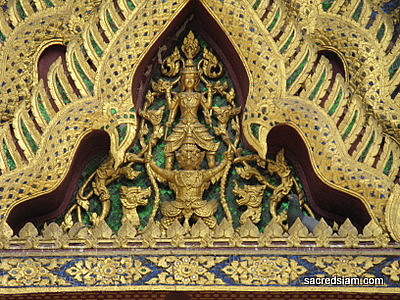The temple (sometimes spelled Phra Buddhabat) is one of Thailand's most sacred pilgrimages due to the natural
Buddha footprint enshrined there.
History
The story of Phra Phutthabat dates from the early seventeenth century, when King Songtham of Ayutthaya (r. 1611-1628)
sent monks to Sri Lanka to worship the Sumankut Buddha footprint. The Sri Lankans told the monks that according to
ancient scriptures the Buddha had also left a footprint in central Siam. On hearing this, King Songtham ordered
a search for the footprint, which was subsequently discovered in 1623 by a hunter, after a wounded
deer he was following emerged from some bushes miraculously healed.
The hunter pushed aside the undergrowth to find a
foot-shaped impression almost two meters long, which immediately cured him of a skin disease. A temple was built on the
site, but was destroyed by the Burmese in 1765. The present buildings were erected by the early kings of Bangkok
and improved upon by subsequent rulers.
Religious festivals held at the temple in the early spring and late fall are among the most sacred in Thailand. An
estimated 800,000 pilgrims attend them in an effort to boost their merit. The first festival, held in the third lunar month, is
popular with Chinese since it corresponds with the Chinese New Year. There is a mural of the fair at Wat Maha Samanaram in
Phetchaburi, painted by Khrua In Khong.
What to see
The temple grounds are guarded by two yak giants, and entrance is made up a long triple staircase flanked by nagas
that is reminiscent of the staircase in murals depicting the Buddha's descent from the Tavatimsa heaven. At the top is an
elegant gold mondop with external columns, a pyramid-shaped roof and doors inlaid with mother-of-pearl. Inside the structure
is enshrined the principal object of worship - a natural rock formation of a Buddha footprint, covered in gold leaf and full
of money from merit-makers.
According to legend, if you ring all of the temple's 93 bells and count them correctly you will live a full 93 years.
Three visits to the wat is believed to ensure rebirth in a celestial realm. Near the top of the naga staircase are statues of
Brahmanical gods for visitors to worship and near the entrance is a small hall where merit-makers try lifting a small
elephant statue. The form is to kneel with the tops of the feet flat on the ground, recite the Three Refuges, and make a
wish. Men use their left hand and little finger to lift the elephant, women use their right hand and index finger.
Beyond the mondop are a number of chedis, and the rocky outcrops can be climbed for a view of the surrounding land.
Getting there
The temple is best seen on a half-day trip from Lopburi. Take
a song-taew (8 baht) from the old town to New Lopburi bus station at the southwest corner of Sakaew Circle, where buses
leave regularly for Phra Phutthabat district.
The trip takes 30 mintues and costs 10 baht. Take a samlor from the bus stop for the 5-minute ride to the temple (30 baht).
If there are no samlors parked outside the temple when you return, it's an easy downhill walk. The bus stop for Lopburi is
on the same side of the main road as the temple. Minivans also run from this bus stop to Sakaew for 13 baht.
Updated: January 23, 2011.




